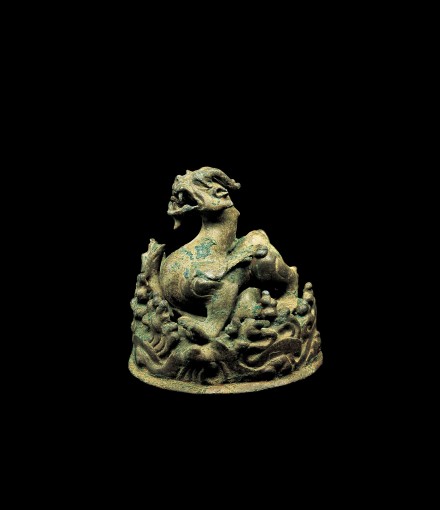J.J. Lally & Co., Oriental Art / New York City, New York
MenuPast Exhibition
Arts of Ancient China
March 27 - April 12, 2006

18.
AN ARCHAIC BRONZE BIXIE-FORM MAT WEIGHT
Han Dynasty (206 B.C. – A.D. 220)
the free-standing mythical beast shown striding on a thick circular base of swirling clouds in rounded relief with spiral points rising to form an irregular openwork border around the tightly coiled feline body of the bixie with short wings curling back from its shoulders and a long tail extending down from the end of its knobby ridged backbone, its head held high in a defiant attitude, with two long horns curling back from the forehead behind large staring eyes set in deep sockets, the mouth open showing sharp fangs and a curled tongue above a pointed beard hanging down from the chin, the jowls with tufts of fur projecting back under the pointed ears, the short powerful legs ending in paw feet with long claws, tramping over the separately cast body of a serpentine dragon shown curled under the bixie with its small head emerging in front of the bixie’s chest, as if struggling to escape, the flat foot of the circular base enclosing a heavy core and showing the ends of bronze pegs extending down from the base of feet of the bixie for attachment to the lead-filled base with an attractive smooth pale green patina all over highlighted with widely scattered bright green encrustation, a fragment of ancient wood adhered to the flat base.
Height 3 1⁄2 inches (8.9 cm)
Compare the related small bronze figure of a bixie, described as a "pacing monster", and assigned to the Han dynasty by Jessica Rawson in the Hong Kong Museum of Art exhibition catalogue entitled Ancient Chinese and Ordos Bronzes, Hong Kong, 1990, p. 202, no. 116. In her description of the "pacing monster," Rawson refers to the recently excavated larger bronze winged beasts found in the fourth century B.C. tombs of the Zhongshan princes at Pingshan in Hebei and refers to a Han jade carving of a similar creature.
Bronze bixie of this type have been dated to the Six Dynasties period in earlier publications, by analogy with the massive stone sculptures of winged feline beasts which were erected in pairs on the "spirit roads" leading to princely tombs of the Southern Dynasties, but more recent scholarship has led to a consensus in favor of an attribution to the Han dynasty. The basic form of a winged feline guardian beast is well established in Chinese imagery of the Han dynasty, and the use of bronze coiled animals as mat weights is a familiar element in Han tomb furniture.
For a discussion of different types of Han weights and their functions, see Sun Ji, Han zhen yishu (Notes on the Arts and Crafts of Han Dynasty Weights), Wenwu, 1983, No. 6, pp. 69-72.
漢 辟邪銅鎮 高 8.9 厘米
18.
AN ARCHAIC BRONZE BIXIE-FORM MAT WEIGHT
Han Dynasty (206 B.C. – A.D. 220)
Height 3 1⁄2 inches (8.9 cm)